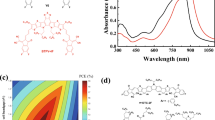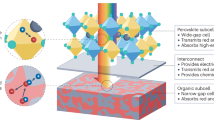Abstract
An effective way to improve the power conversion efficiency of organic solar cells is to use a tandem architecture consisting of two subcells, so that a broader part of the solar spectrum can be used and the thermalization loss of photon energy can be minimized1. For a tandem cell to work well, it is important for the subcells to have complementary absorption characteristics and generate high and balanced (matched) currents. This requires a rather challenging effort to design and select suitable active materials for use in the subcells. Here, we report a high-performance solution-processed, tandem solar cell based on the small molecules DR3TSBDT and DPPEZnP-TBO, which offer efficient, complementary absorption when used as electron donor materials in the front and rear subcells, respectively. Optimized devices achieve a power conversion efficiency of 12.50% (verified 12.70%), which represents a new level of capability for solution-processed, organic solar cells.
This is a preview of subscription content, access via your institution
Access options
Subscribe to this journal
Receive 12 print issues and online access
$209.00 per year
only $17.42 per issue
Buy this article
- Purchase on Springer Link
- Instant access to full article PDF
Prices may be subject to local taxes which are calculated during checkout




Similar content being viewed by others
Change history
19 December 2016
In the version of this Letter originally published online, in Fig. 1c, the bottom two values on the y axis were incorrect. This has now been corrected in all versions of the Letter.
References
You, J., Dou, L., Hong, Z., Li, G. & Yang, Y. Recent trends in polymer tandem solar cells research. Prog. Polym. Sci. 38, 1909–1928 (2013).
Service, R. F. Outlook brightens for plastic solar cells. Science 332, 293 (2011).
He, Z. et al. Single-junction polymer solar cells with high efficiency and photovoltage. Nat. Photon. 9, 174–179 (2015).
Zhao, J. et al. Efficient organic solar cells processed from hydrocarbon solvents. Nat. Energy 1, 15027 (2016).
Kan, B. et al. A series of simple oligomer-like small molecules based on oligothiophenes for solution-processed solar cells with high efficiency. J. Am. Chem. Soc. 137, 3886–3893 (2015).
Zhang, S. et al. Realizing over 10% efficiency in polymer solar cell by device optimization. Sci. China Chem. 58, 248–256 (2015).
You, J. et al. A polymer tandem solar cell with 10.6% power conversion efficiency. Nat. Commun. 4, 1446 (2013).
Zheng, Z. et al. Highly efficient tandem polymer solar cells with a photovoltaic response in the visible light range. Adv. Mater. 27, 1189–1194 (2015).
Yusoff, A. B. et al. A high efficiency solution processed polymer inverted triple-junction solar cell exhibiting a power conversion efficiency of 11.83%. Energy Environ. Sci. 8, 303–316 (2015).
Chou, C.-H., Kwan, W. L., Hong, Z., Chen, L.-M. & Yang, Y. A metal-oxide interconnection layer for polymer tandem solar cells with an inverted architecture. Adv. Mater. 23, 1282–1286 (2011).
Zuo, L. et al. Design of a versatile interconnecting layer for highly efficient series-connected polymer tandem solar cells. Energy Environ. Sci. 8, 1712–1718 (2015).
Kouijzer, S. et al. Efficient inverted tandem polymer solar cells with a solution-processed recombination layer. Adv. Energy Mater. 2, 945–949 (2012).
Zhou, H. Q. et al. Polymer homo-tandem solar cells with best efficiency of 11.3%. Adv. Mater. 27, 1767–1773 (2015).
Li, N. et al. Design of the solution-processed intermediate layer by engineering for inverted organic multi junction solar cells. Adv. Energy Mater. 3, 301–307 (2013).
Gilot, J., Wienk, M. M. & Janssen, R. A. J. Optimizing polymer tandem solar cells. Adv. Mater. 22, E67–E71 (2010).
Gevaerts, V. S., Furlan, A., Wienk, M. M., Turbiez, M. & Janssen, R. A. J. Solution processed polymer tandem solar cell using efficient small and wide bandgap polymer:fullerene blends. Adv. Mater. 24, 2130–2134 (2012).
Dou, L. et al. Tandem polymer solar cells featuring a spectrally matched low-bandgap polymer. Nat. Photon. 6, 180–185 (2012).
Zheng, Z. et al. Over 11% efficiency in tandem polymer solar cells featured by a low-band-gap polymer with fine-tuned properties. Adv. Mater. 28, 5133–5138 (2016).
Mishra, A. & Bäuerle, P. Small molecule organic semiconductors on the move: promises for future solar energy technology. Angew. Chem. Int. Ed. 51, 2020–2067 (2012).
Lin, Y. & Zhan, X. Oligomer molecules for efficient organic photovoltaics. Acc. Chem. Res. 49, 175–183 (2016).
Gao, K. et al. Deep absorbing porphyrin small molecule for high-performance organic solar cells with very low energy losses. J. Am. Chem. Soc. 137, 7282–7285 (2015).
Liu, Y. et al. Solution-processed small-molecule solar cells: breaking the 10% power conversion efficiency. Sci. Rep. 3, 3356 (2013).
Riede, M. et al. Efficient organic tandem solar cells based on small molecules. Adv. Funct. Mater. 21, 3019–3028 (2011).
Zhang, Q. et al. Evaluation of small molecules as front cell donor materials for high-efficiency tandem solar cells. Adv. Mater. 28, 7008–7012 (2016).
Kan, B. et al. Solution-processed organic solar cells based on dialkylthiol-substituted benzodithiophene unit with efficiency near 10%. J. Am. Chem. Soc. 136, 15529–15532 (2014).
Gao, K. et al. Multi-length-scale morphologies driven by mixed additives in porphyrin-based organic photovoltaics. Adv. Mater. 28, 4727–4733 (2016).
Pattanasattayavong, P., Mottram, A. D., Yan, F. & Anthopoulos, T. D. Study of the hole transport processes in solution-processed layers of the wide bandgap semiconductor copper(I) thiocyanate (CuSCN). Adv. Funct. Mater. 25, 6802–6813 (2015).
Gilot, J., Wienk, M. M. & Janssen, R. A. J. Measuring the external quantum efficiency of two-terminal polymer tandem solar cells. Adv. Funct. Mater. 20, 3904–3911 (2010).
Timmreck, R. et al. Characterization of tandem organic solar cells. Nat. Photon. 9, 478–479 (2015).
Zhang, Q. et al. Small-molecule solar cells with efficiency over 9%. Nat. Photon. 9, 35–41 (2015).
Shrotriya, V. et al. Accurate measurement and characterization of organic solar cells. Adv. Funct. Mater. 16, 2016–2023 (2006).
Acknowledgements
The authors acknowledge financial support from MoST (2014CB643502, 2016YFA0200200), NSFC (51373078, 51422304, 91433101, 51323003, 51473053) and the International Science and Technology Cooperation Program of China (2013DFG52740).
Author information
Authors and Affiliations
Contributions
M.L. fabricated and characterized the devices with help from Q.Z. K.G. synthesized the donor material DPPEZnP-TBO. B.K. synthesized the donor material DR3TSBDT. X.Y. and H.F. prepared the ZnO electron transport material. J.P. and Z.L. performed the experiments on the measurement of n and k. H.Y. performed the optical simulations. Y.Ch. and X.W. supervised and coordinated the study. All authors discussed the results and commented on the manuscript.
Corresponding authors
Ethics declarations
Competing interests
The authors declare no competing financial interests.
Supplementary information
Supplementary information
Supplementary information (PDF 3342 kb)
Rights and permissions
About this article
Cite this article
Li, M., Gao, K., Wan, X. et al. Solution-processed organic tandem solar cells with power conversion efficiencies >12%. Nature Photon 11, 85–90 (2017). https://doi.org/10.1038/nphoton.2016.240
Received:
Accepted:
Published:
Issue Date:
DOI: https://doi.org/10.1038/nphoton.2016.240
This article is cited by
-
Recent synthetic strategies of small heterocyclic organic molecules with optoelectronic applications: a review
Molecular Diversity (2024)
-
Influence of azacycle donor moieties on the photovoltaic properties of benzo[c][1,2,5]thiadiazole based organic systems: a DFT study
Scientific Reports (2023)
-
Tandem organic solar cells with efficiency over 19% via the careful subcell design and optimization
Science China Chemistry (2023)
-
Designing Y-shaped two-dimensional (2D) polymer-based donor materials with addition of end group acceptors for organic and perovskite solar cells
Journal of Molecular Modeling (2023)
-
Tandem organic solar cells with a large VOC by control of the active-layer concentration
Applied Physics A (2023)



